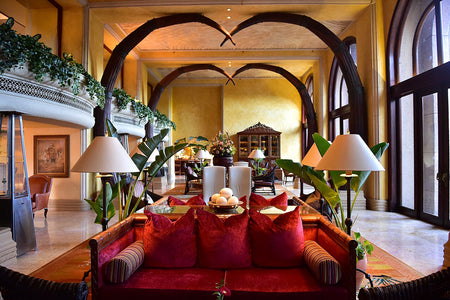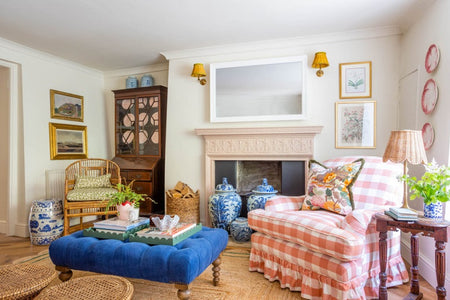 Eltham Palace. Image: English Heritage
Eltham Palace. Image: English Heritage
Opulence, glamour and sleek lines…. Continuing our series on the great interior decor trends and how you can use them for inspiration in your own home (with a special emphasis on lighting), here’s a guide to Art Deco interior design.
See also: Classic interior design styles and how to light them – 1. Mid-Century Modern 2. English Country House style 3. Industrial style 4. Eclectic style 5. Coastal style 6. Scandinavian style Few architectural and design styles are so instantly recognisable as Art Deco, with its distinctive lines and unashamed opulence. In the 1920s and 30s, Art Deco was everywhere, from Busby Berkeley’s glamorous Hollywood film sets to Lubetkin’s Penguin Pool (which was not, at it turned, particularly good for penguins) at London Zoo. Art Deco buildings began to appear around the world a century ago but the impact of WWll meant a scarcity of raw materials and limits on building and furniture production and Art Deco rather faded into insignificance. But it did not disappear completely and, since a revival in the late 1960s and ‘70s, Art Deco has continued to influence buildings, interior design, furniture, furnishings and accessories. So what is it that makes this style so compelling and how can you introduce Art Deco features, including lighting, into a 21st century home?
The origins of Art Deco style
It was the Exposition internationale des arts décoratifs et industriels modernes, staged in Paris in 1925, which gave Art Deco its name and put this unmistakable style firmly on the international design map. Originally planned in 1912, the exhibition was intended to revive and promote French design, which had been overshadowed in the early years of the 20th century by the groundbreaking design work coming out of Austria and Germany. Although the First World War had delayed the exhibition, Art Deco buildings had already appeared in many parts of the world. The Kologdam Building in Bandung, Indonesia for example, dates from 1920.Features of Art Deco design
Think geometrical shapes and symmetrical designs reflecting modern machinery, strong colours, painting styles such as Cubism and Italian Futurism; combine them with luxurious and opulent materials, such as marble and lacquer, and sumptuous fabrics like velvet and satin, and you have the essence of Art Deco. It’s a Bugatti Royale Type 4, a Danish velvet chair or a 1920s flapper dress. 1930s Bugatti Royale Type 4
1930s Bugatti Royale Type 4
But metal and synthetic materials, plastic and Bakelite, for example, also featured and enabled everyday objects in Art Deco style to be mass produced.
Art deco buildings
 Bathroom, Upton House. ©National Trust Images
Bathroom, Upton House. ©National Trust Images
If you have drive west from London, along the Great West Road or Western Avenue, you can still see examples of Art Deco’s industrial legacy, such as Wallis, Gilbert and Partners’ Firestone Tyre Factory and the Hoover Building at Perivale. But the movement had an equally strong influence on domestic buildings and hotels. Art Deco houses and apartment blocks were appearing in towns and cities across the country. Nowhere epitomised Art Deco luxury more than the 80 new hotel rooms and ballroom designed by architect, Oswald Milne for Claridge’s. And, with, arrival of Oscar Deutsch’s Odeon cinema chain, going to the movies became unbelievably glamorous. The there were the grand old country houses whose smart set owners redecorated in Art Deco style, such as Upton House in Warwickshire and the quite extraordinary Eltham Palace in Greenwich.
 Dining room, Eltham Palace
Dining room, Eltham Palace
Art Deco in the 1960s and ‘70s
In the late 1960s and 1970s, many of the clothes designed Barbara Hulanicki (Biba) and Lee Bender (Bus Stop) reflected Art Deco styles and fabrics. When Big Biba, Biba’s department store in Kensington High Street, opened in 1973, it was a celebration not only of Hulanicki’s own unique style but of the building’s original Art Deco opulence - and much more besides. Vogue’s editor-in-chief, Anna Wintour, started her fashion career there aged 15... Big Biba
Big Biba
The revival trend tipped over into homes; Art Deco furniture (think glass-fronted walnut cabinets), was suddenly desirable again and entire suites of furniture, which had fallen out of favour, could still be picked up in secondhand furniture warehouses for quite modest sums.
Getting the Art Deco look in the 21st century home
If you love Art Deco style, you’ve probably already discovered that original furniture of the period in good condition can now command eyewatering sums, although you may be able to track down an occasional gem at auctions or online. So here are some more affordable tips: 1. Go ersatz. Keep a lookout contemporary pieces with a retro Art Deco look, like this scallop shell chair, upholstered in pink velvet. 2. Use tiles. Geometric tiles in black, white and green featured strongly in Art Deco bathrooms and kitchens and that’s a look you can easily adapt in your own home. And many bathroom manufacturers offer a range of retro styles, including Art Deco hand basins. Image: Shanade McAllister-Fisher
Image: Shanade McAllister-Fisher
3. Vintage cabinets. Look out for vintage Art Deco kitchen cabinets. Not only do they look good but they are highly practical too; most feature a pull-down or pull-out enamel worktop - perfect for practising. Bake-Off skills, They’re compact too, so they work well in small kitchens. 4. Geometric wallpaper and stencils. In a hallway, make a statement with dramatic black and white floor tiles, or Art Deco style wallpaper or stencils, like these ones. 5. Posters. Look out for high quality reproduction prints like these Eduardo Benito covers for Vogue from the 1920s:

Lighting your Art Deco home
As with furniture and accessories, it’s perfectly possible to find contemporary lighting that will enhance a dedicated Art Deco interior, or add just a touch of Art Deco to a modern interior. Pooky has you covered!Art Deco wall sconces
No type of lighting says Art Deco more than highly stylised angular wall sconces, adorned with Egyptian motifs or jewel encrusted. And no novel sums up the Art Deco era, with all its glamour and excesses, than F. Scott Fitzgerald’s The Great Gatsby. So, when we created this stunning Cubist brass and alabaster wall sconce, what else could we possibly call it but...the Gatsby? It would have looked perfectly at home in a stateroom in one of those elegant liners of the 1930s. If Follow the Fleet with Fred and Ginger is one of your favourite films or you visited the V&A’s Ocean Liners: Speed and Style exhibition in 2018, you’ll know just what we mean.
Art Deco table lamps
Art Deco floor lamps
Perfecting the Art Deco look in a table lamp is quite a challenge. We had several attempts at the Albert, with our Porto-based designer, Jorge, before we got the angles and proportions of the square-based column just right. We love the finished version and we think you will too. For the finishing touch of luxury add a cream or off-white shade in a sumptuous fabric like velvet or taj silk.
Art Deco ceiling lights and chandeliers
 Loki
Loki
Passionate about Art Deco? Take a look at this Pooky article, the third in our series on the history of design in table lamps. Browse our range of affordable designer lighting here.











